|
JOSÉ SERGIO GABRIELLI
|
|
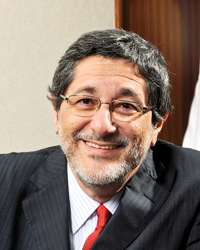
Named 2011 Petroleum Executive of the Year by the Energy Intelligence information service, JOSÉ SERGIO GABRIELLI took office as Petrobras CEO in 2005. He previously served as the company’s CFO and CIO from 2003 to 2005. A full professor in macroeconomics on leave from the Federal University of Bahia, Gabrielli holds a PhD in economics from Boston University. Gabrielli participated in a Q&A session with this editor and reporters from Reuters, the Financial Times, The Economist and the Houston Chronicle.
|
|
Extending 500 miles across the Santos, Campos and Espirito Santo basins, Brazil’s presalt fields hold an estimated 10–16 billion boe. Petrobras prides itself on being a leading deepwater operator, but with plans to increase presalt oil production twentyfold within the next decade, the company is hedging its bets by strengthening its technology portfolio and even inviting international service companies to build R&D facilities in Brazil to collaborate on solving presalt drilling and production challenges. In early February, World Oil Editor Pramod Kulkarni had the opportunity to visit Brazil, participate in a group interview with Petrobras CEO José Sergio Gabrielli, tour the Petrobras-affiliated research facilities in Rio de Janeiro and Sao Paolo and attend a presentation on R&D at the company’s Cenpes research center by its executive manager, Carlos Tadeu Fraga.
Question: There are announcements of presalt discoveries almost every other week. What do you estimate to be the full potential of the presalt reservoirs?
José Sergio Gabrielli: The presalt region, as we know it now, covers 145,000 sq km, of which 42% is under concession. All of the recent discoveries have been made in this 42% portion. Outside of this portion, we have drilled only three wells, one of which has resulted in the Libra discovery. So about 68% of the region is unknown. Given the model we have of the geological conditions 130 million years ago when the South American and African continents were one and the process of separation that created the presalt region, we believe there are enormous resources that we can tap. But we have to drill to find out. We have already produced nearly 10 million bbl from the presalt region since May 2009 at the rate of 35,000 to 45,000 bopd. At the beginning of 2012, we will be connecting more wells in the Lula [previously Tupi] field that will increase production to 120,000 bopd.
Q: Are you still planning to build 28 new drilling rigs?
Gabrielli:Yes. We’re in the bidding phase right now with seven different proposals under consideration. All of these proposals are for high-technology deepwater drilling rigs for working in 10,000 ft of water and beyond. We’ll announce the bid results once the technical and financial analyses are complete. The new rigs are expected to come into operation in 2015.
Q: Would you consider presalt to be moving from the stage of “unknown unknowns” to “known unknowns”?
Gabrielli: I don’t think that is right. We now pretty much have all the technology needed for the surface facilities. And we know all the technology for the subsea systems, and for drilling. We can improve, yes. What we don’t know is how the reservoir will behave. That depends on the pressures we encounter and the pressure gradients and temperatures. This is a natural phenomenon. As we drill wells, we open reservoirs that have been locked up for millions of years. We have to control the pressures and achieve a high recovery factor. We are learning these processes through the pilot projects. We’ll be alternately conducting water, CO2 and natural gas injection to find out the best means of achieving high sweep rates. The other issues we need to solve are wellbore instability due to the mobility of the salt layer and corrosion due to CO2 content in the natural gas stream.
Q: What is your policy regarding local content for oilfield equipment?
Gabrielli: We have broken down the presalt projects into 3,200 components with a different local content approach for each of these components. Some of them can have local content. Other components may never have local content because of high technology or scale. Regarding the construction of 28 drilling rigs, we’re meeting with supply chain vendors to find out where there might be bottlenecks. We’re even planning to acquire seven vessels from one shipyard to help it achieve efficiency through scale. Our needs are enormous. We need more than 500 wet Christmas trees, more than 42,000 km of flexible risers, 30,000 km of umbilicals, 146 supply boats and 72 large oil tankers.
Q: What kind of R&D effort is the presalt development creating?
Gabrielli: We have our own R&D programs underway and also numerous programs with the local universities. Plus, we have invited major international companies to build 14 R&D facilities here. This includes Schlumberger, Baker Hughes, GE, FMC, IBM and others. In the past, R&D was conducted elsewhere and the local content was only in manufacturing. We’re now moving even R&D in the direction of local content. We have also financed and built R&D facilities in more than 70 Brazilian universities that are interconnected through a thematic network that has required more than 10,000 m of optical fiber. We have built ocean tanks for testing physical models, and doubled the computing capacity to 190 teraflops to support increased simulation capability.
Q: Are you considering setting up your own service companies, such as Halliburton and Schlumberger, to further encourage local content?
Gabrielli: No. We’re an oil company that is rewarded by taking risks. The service companies charge for their services—very high fees, I might add. We don’t want to compete with them.
Q: How are your relationships with other operators evolving?
Gabrielli: We’re used to working with other international oil companies and have built numerous partnerships here in Brazil as well as in fields around the world with companies such as BG, Galp, Repsol, Shell, ExxonMobil, Total, Chevron, Hess and Statoil. Some of the international companies decided to take the presalt risk with us, and they are already benefiting. When you’re a latecomer, you’re penalized and you have to pay more. But many of these companies are now eager to participate in presalt projects with Petrobras as the sole operator. But it is not a monopoly. The IOCs can come and share the risk, share technologies and share the rewards.
Q: How is it that Petrobras has been able to achieve such a remarkable presalt success rate that others have not been able to replicate? For example, ExxonMobil has experienced three dry holes in presalt drilling.
Gabrielli: I can’t speak for the others, but at Petrobras, we have a broad overall approach. We have invested in acquiring knowledge of the entire region rather than restricting ourselves only to the specific view of one or two blocks. We can conduct a broad regional analysis by comparing logs from several wells from several blocks. We’re the best in operations and the best in the knowledge of the presalt reservoirs. That’s why it makes sense for Petrobras to be the sole operator.
|
CARLOS TADEU FRAGA
|
|
.jpg)
CARLOS TADEU FRAGA has been the executive manager of Cenpes, Petrobras’ R&D center in Rio de Janeiro, since 2003. He is responsible for conducting R&D projects in upstream, downstream and renewable energy. Fraga holds a bachelor’s degree in civil engineering from the Federal University of Rio de Janeiro, and postgraduate degrees in petroleum engineering from the University of Alberta, in business administration from Columbia University in New York and in technology management from INSEAD in France. During his 20-year career, Fraga has worked in both the Gulf of Mexico and the Campos basin.
|
|
Petrobras R&D profile
Cenpes chief Carlos Tadeu da Costa Fraga made a presentation about Petrobras technology resources and how they are being used to tackle challenges related to presalt development.
Cenpes. Petrobras currently produces over 90,000 bopd from the presalt fields in the Santos and Campos basins. The company plans to increase that output to 220,000 bpd by 2013, and to reach 1.8 million bpd by 2020.
In order to achieve these ambitious production targets, Petrobras must develop innovative solutions to drill efficiently through the salt layers, often under high-temperature conditions, and produce well fluids that contain corrosive carbon dioxide in the natural gas stream.
To this end, the company has invited the major international service providers to build R&D centers in its extensive Cenpes research facility in Rio de Janeiro. There, the service companies and Petrobras apply their combined resources to solve complex upstream challenges from seismic imaging through the salt and formation evaluation of carbonate presalt reservoirs to designing reliable subsea completion and production systems.
Created in 1963, Cenpes employs 1,629 technical staff, of whom 807 are graduate researchers. The facility was expanded in October by 200,000 sq m to a total of 300,000 sq m. As a result, Cenpes now has 130 laboratories and 30 pilot plants.
From 2008 through 2010, Petrobras increased its R&D expenditures five times compared with the 2001–2003 level, to $820 million per year. At this rate, Petrobras ranks seventh among the leading oilfield R&D companies. As a part of its obligation under the country’s R&D investment stimulation laws, Petrobras has spent $250 million in R&D infrastructure and projects with the local universities and research institutions.
Petrobras innovations include the patented Torpedo piles capable of restraining 1,000–2,000 metric tons of floating weight, resulting in a savings of over $1 billion in mooring costs thus far. Petrobras has also conducted leading research in rigid risers that are suitable for subsea installations at 2,200-m water depth and beyond.
“We’re not scared of presalt,” Fraga said. “We discovered the Roncador field in 2001. Since then, we’ve built our expertise in presalt imaging, subsea installations and production using FPSOs. With integrated R&D from Brazilian institutions and international service suppliers, we’re creating an environment that will foster innovations like the Silicon Valley.”
Galilleu thematic network. Petrobras has developed a thematic network for integrated computing and 3D visualization that is being used for presalt R&D in the fields of ocean engineering, foundation engineering, presalt well design, risers and mooring design, reservoir engineering and visualization of multiphysical phenomena. The network allows R&D institutions to share computing resources and to view simulation results at any location in real time via the Internet.
Nodes on the network include Cenpes, universities in Rio and Sao Paolo and international institutions such as the Massachusetts Institute of Technology, Cornell University in Ithaca, New York, the University of Salford in the UK and Det Norske Veritas. All told, the network provides 190 teraflops of total computing resources.
Challenges that have been undertaken through the network include the conceptualization of the P55 production platform hull used at Roncador field in the Campos basin and similar conceptualization projects for platforms to operate in the presalt oil and gas fields.
COPPE Lab Oceano. At the Federal University of Rio de Janeiro, the Institute for Graduate Studies in Engineering (COPPE) operates Lab Oceano, a water tank capable of physically simulating a marine environment in water depths exceeding 2,000 m.
The 40 m 3 30 m tank, with an overall depth of 15 m, holds 23 million liters of water. There is an additional depth of 10 m in a central well. The tank includes wave and wind generators to test physical models of offshore vessels under challenging weather conditions. There only two other water tanks in the world of comparable capabilities, the Marintek tank in Norway at a depth of 10 m and the Marin tank in the Netherlands, which is 10.5 m deep.
USP test tank and viewing room. The University of Sao Paulo operates a numerical test tank (NTT) and a physical tank for improving the design of hydrodynamic hulls of floating production platforms. The tank is capable of simulating the impact of waves in the presalt region using a small-scale model of the platform. The facility also has an auditorium equipped with projection technology capable of 4D simulation. A mobile platform allows the analyst to immerse into the virtual environment. 
| |
|
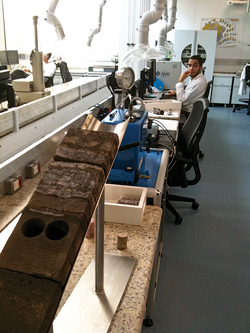
A geologist at Cenpes evaluates core samples from the presalt carbonate formations.
|
|
| |
|
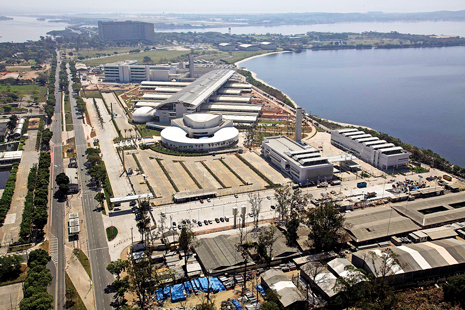
Petrobras’ sprawling Cenpes research facility was recently expanded, with 14 individual R&D facilities built by international partners such as Schlumberger, Baker Hughes and Halliburton to conduct joint research on presalt challenges.
|
|
|
.jpg)
Cenpes engineers use interactive tools to test the capabilities of the facility's immersive 3D simulation room.
|
|
Aboard the FPSO Cidade de Angra Dos Reis
While Brazil faces numerous presalt subsea and downhole challenges, the country is blessed with relatively calm weather on the surface. This was evident during a visit to the FPSO Cidade de Angra dos Reis, where the strong winds came from the whirling of the helicopter that had just landed. Walking on the decks, one felt only a gentle roll of the massive production vessel.
Owned by Modec and leased to Petrobras for a 15-year term followed by five one-year lease options, the FPSO is moored in 2,149 m of water in the recently renamed Lula field (formerly Tupi) in the Santos basin, about 250 km offshore Rio de Janeiro. At full capacity, the FPSO will gather up to 100,000 bopd and 180 MMcfd of natural gas from five subsea wells. The FPSO will also be connected to one water injector, a gas injector and an injector capable of alternating gas and water injection. Equipment aboard the vessel is designed to extract H2S and CO2. The latter can be reinjected at about 8,000 psi. As part of a long-duration test, and also due to regulatory restrictions on gas flaring, production is currently restricted to 14,000 bopd and 70 cu ft of gas per day until a gas pipeline is completed to the nearby Mexilhao platform for transport to onshore processing facilities.
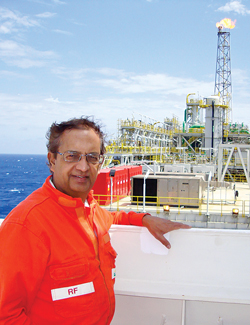
World Oil Editor Pramod Kulkarni on the wheelhouse deck of the FPSO with the flare stack in the background.
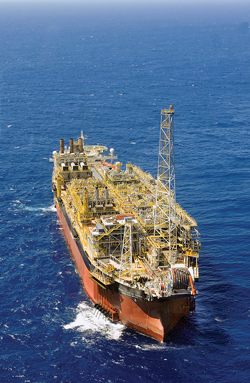
Modec converted the Sunrise IV crude tanker in a Singapore yard into an FPSO designed specifically for the presalt fields. The vessel was renamed after the city of Angra, located south of Rio de Janeiro.
|
|


.jpg)


.jpg)



